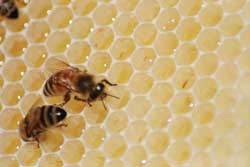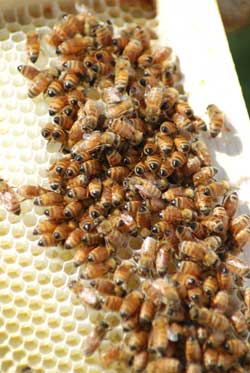Syndicated from NW News: http://nwnews.com/old/editions/2008/080818/front1.htm

Some bees are misunderstood, according to James Olsen.
The Woodinville man and self-professed beekeeper believes that honey bees, in particular, get a bum rap. “They’re far gentler than most people think,” he says. “They’re really not aggressive creatures, but they get lumped with other species like wasps and hornets, which will go after you with a vengeance.”
Olsen is on the board of the Puget Sound Beekeeper Association and has been a beekeeper for the past nine years. A friend got him interested in the hobby, which eventually turned into a small side business for him when he began collecting and selling the honey to local outlets.
“My first hive was an eye-opening experience for me,” comments Olsen. “I found that I really enjoyed watching the bees because they’re so intriguing. It’s amazing to see how industrious they are. They’re always so busy.” The one hive turned into two and then three and before the Woodinville man knew it, he had a collection of colonies.
Today, he tends to 25 hives located within the valley in Woodinville; the majority of which are at the Root Connection, where he also sells his honey. Learning about bees has been an on-going process for Olsen, but he says that because they’re one of the most studied insects in the world, there is a wealth of information available. He remarks, “They’re studied so much because they’re so important to us as people. Every third bite of food we eat depends on the pollination of bees. They’re responsible for pollinating so many different crops, from nuts to fruits and vegetables. They’re an 18 billion dollar industry in the U.S.”
 These bees are doing what they do best – making honey.
These bees are doing what they do best – making honey.
Recently, there has been a noticeable decline in the number of bees worldwide, which concerns researchers and scientists, as well as farmers and the entire agricultural industry.
“It’s really serious,” comments Olsen. “It’s a problem that has begun to affect our food source. For example, there aren’t enough bees in the country to pollinate the almond crop in California and growers are struggling. Almond production is way down. And that’s just one crop, among many, that’s affected.”
Part of the problem points to colony collapse disorder, a mysterious condition that reduces a thriving colony of 40 to 60 thousand bees down to nothing within just a week or two. The disease is prevalent around the globe and no one seems to know what causes it.
“It’s very bizarre to have a healthy colony one week and then to have nothing remaining the next,” adds Olsen. “And no one knows where the bees go. Beekeepers are reporting a fifty to seventy-five percent loss of their hives per year. It’s very scary.”
Colony collapse differs from a condition known as “swarming,” which is Mother Nature’s way of splitting an existing hive. In this natural phenomenon, which takes place between the months of May and July, the queen bee will take half of her hive and move about 150 feet away. Those that have left will proceed to surround the queen in a clump and soon they will look for a place to create a new hive. The bees that remain in the existing hive will rear a new queen to replace the former one.
During swarm season, interested and experienced beekeepers, such as Olsen, have their names on a list to be contacted when people report swarms in their area. He says, “We go out and collect the swarms. It’s not only a service to the public, but it allows us to get bees for free.”
When Olsen gets a call, he first determines if it is indeed a swarm of honey bees and not a nest of yellow jackets, for example. Many of the swarms reported do not consist of honey bees. “Usually, people don’t know what they have in their yards,” explains Olsen. “They are concerned and even afraid and just want to attack the swarm with a can of Raid. But, if they can call us, we’ll help to identify what they have and possibly prevent them from harming what could be a hive of honey bees.”
After making a positive determination, the beekeeper will collect the honey bees in a special box and transport them to a new destination. The bees will then create a new home in the box and eventually begin to produce honey. Each hive can produce from 100 to 150 pounds of honey a year. Olsen averages approximately 2,000 pounds annually with his collection of hives. The type of honey changes according to the different seasons.
“Bees look to nectar sources and grab onto whatever’s readily available nearby to them,” says the Woodinville man. “When blueberries are in season, you’ll get blueberry honey for example. And when blackberries are in, you’ll get blackberry honey. The varieties are wonderful.”
Tending to the hives is a year-round responsibility.
During swarm season, Olsen inspects each of his hives once every three or four days. The rest of the year, it’s usually once every two weeks. He determines the health of the hive by checking the number of eggs there are, how much honey is packed on the frames and whether the queen has enough room to lay her eggs. He dresses appropriately when he makes his inspections, wearing a cotton coat with a hooded bee veil and gloves.
It’s rare that the Woodinville man gets stung these days, though when he first began, he was a frequent target. “You learn when to inspect them and what makes them irritable,” he adds. “On the whole, as I’ve said, they’re actually very gentle and not aggressive in the least.”
Though beekeeping can be big business, Olsen cautions those who see dollar signs when they consider entering the industry.
He says, “Don’t quit your day job unless you’re willing to really go big and invest both time and money. It’s hard work, very physical, and it can also be challenging to maintain healthy hives, especially with all the conditions that can affect the health of the bees.”
But, the Woodinville man adds that beekeeping, simply as a hobby, can be extremely rewarding. He enjoys working with such interesting creatures, sharing the honey they produce and helping to educate others about what he terms, “nature’s fascinating workaholics.”
